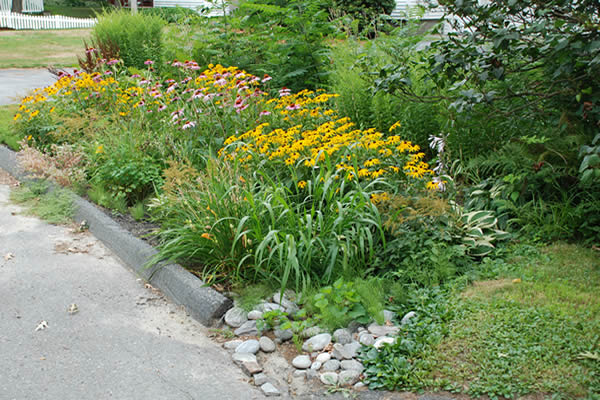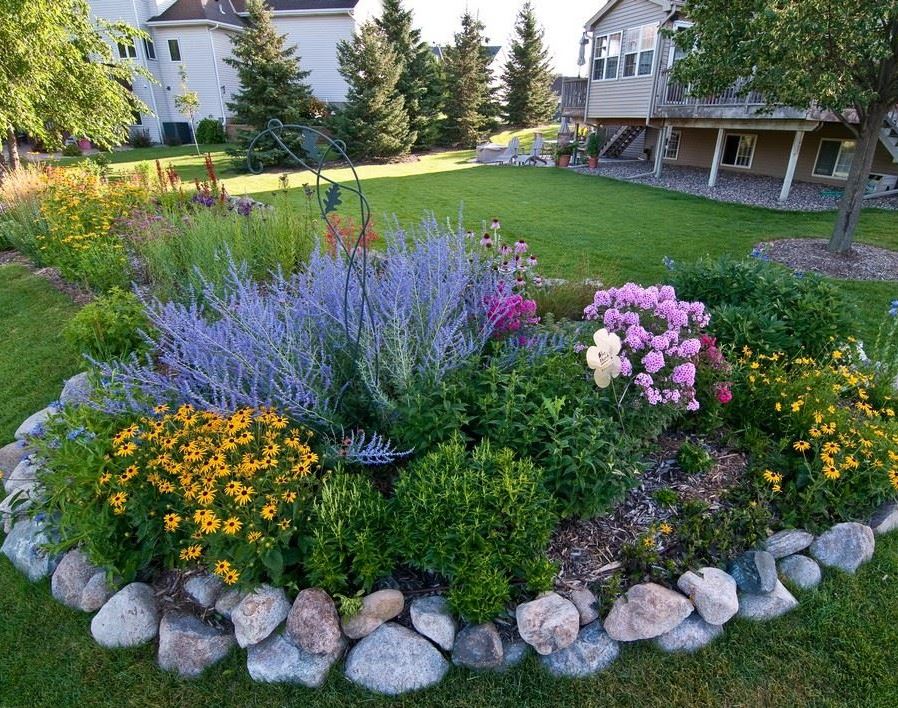What Is a Rain Garden?
A rain garden is a landscaped area, planted with wildflowers and other native vegetation, that soaks up rain water, mainly from the roof of a building or a low area that captures runoff. They are generally planted in a shallow depression where it will intercept storm water runoff. Rain gardens also need good drainage so that water runs off within a 24-hour period, to avoid creating a mosquito habitat.
Lawn grasses are not effective at capturing rain water. Unlike native plants that have deep root systems, lawns have shallow roots. It’s estimated that as much as 80% of rain water will run off a lawn, depending on the density of the turf.


Why Install a Rain Garden?
There are many benefits of a rain garden, some more visible than others:
1) Rain gardens increase the amount of water that filters into the ground and recharges aquifers.
2) They help to protect our community from flooding and drainage problems.
3) Rain gardens protect nearby waterways from pollutants such as lawn fertilizers, pesticides, animal waste, oil and trash which may have accumulated on lawns and sidewalks.
4) They enhance the beauty of our yards and neighborhoods.
5) They provide a habitat for birds, butterflies and beneficial insects.
6) Rain gardens reduce lawn maintenance – less mowing and fewer fertilizers are needed.
Things to Consider Before Creating a Rain Garden:
(This content is provided for informational purposes only and is not comprehensive. You are encouraged to do additional research. NWWA does not warrant that this information will meet your needs or expectations, or that all nonconformities can or will be corrected.)
Site Selection – It’s important to take advantage of the topography of your property and take advantage of your property’s exiting drainage patterns. If rain doesn’t flow to your preferred location, you can use underground piping to divert rain water from your roof or you can create a channel or swale.
Your garden should be located downslope and at least 10 feet from the foundation of your house if you have no basement; 30 feet if there is a basement. It’s also important to stay away from a septic field.
Determining Garden Size and Depth – Residential rain gardens are typically 100-square-feet or less in size and 6-8″ deep. To determine the depth of your garden, you’ll need to perform an infiltration test. To determine the surface area or size, you’ll need to measure your drainage area and divide that by your depth measurement.
Before You Dig – At least three days before you begin any digging, call Pennsylvania One Call at 8-1-1 or 1-800-242-1776 to mark out the underground utility lines. Making this call will help prevent property damage and potential injuries.
Plant Selection – Choose native plants that are attractive to you! Use native hardy perennial species with well-established root systems that survive in both dry and wet conditions. Click here for a list of native plants suitable for rain gardens. You will find additional native plant lists in the Online Resources section below. Click here for a list of area nurseries that specialize in native plants.
Digging and Planting – Dig to the desired depth and use the shoveled out soil to build up a berm at the low end of the garden. Carefully level the base top prevent ponding. Plants should be watered immediately after planting and twice a week (unless it rains) until established. After the first year, the plants will be established and will only need water during hot, dry spells. Check the resources below for more in-depth instructions and information.
Care and Maintenance – A rain garden will require less maintenance than a lawn, but some general maintenance should include: weeding, pruning, revegetating, and soil testing.
Online Resources:
(The resources on this list are provided for informational/educational purposes only and does not indicate an endorsement or recommendation of any resource.)
The following offer more in-depth rain garden information.
What is a Rain Garden (Perkiomen Watershed Conservancy)
Rain Gardens – The Plants (Penn State Extension)
Rain Gardens – Saving One Stream at a Timel (StormwaterPA)
Sample Garden Designs (Audobon Society of Western PA)
Native Plants for Rain Gardens (Stroud Water Research Center)